How to Buy an Asscher-Cut Diamond Engagement Ring

Modest brilliance yet high status — the Asscher is the ultimate symbol of wealth in the world of diamond shapes. With its unmistakable octagonal vintage look and a legacy spreading for over a century, the Asscher cut is reserved for true diamond connoisseurs as there is no other cut like it.
A historical cut that peaked in popularity during the Roaring Twenties, the Asscher still has many followers today. Celebrities Jessica Alba, Zooey Deschanel, and British socialite Pippa Middleton share an Asscher cut diamond engagement ring in common.
But what is it about this regal shape that makes it so unique? Where does the name Asscher come from? And what should you know before buying an Asscher cut engagement ring? At Ritani.com, we want you to explore all the diamond shapes available and understand how to choose the one that’s perfect for you.
KEEP READING TO DISCOVER:
• The Origin and History of The Asscher Cut
• How to Choose an Asscher Cut Diamond
• Find Inspiration in Ritani’s Asscher Cut Diamond Engagement Rings
It is currently estimated that only 2% of diamonds are cut into this shape, thus making the Asscher a highly desired cut. Elizabeth Taylor brought it back into fashion in 1968 when she was presented with a 33 carat Asscher cut diamond ring by her then-husband, Richard Burton.
Save Up and Buy a Lab-grown Asscher Cut Diamond
History of The Asscher Cut Diamond
In 1864, Joseph Isaac Asscher founded the I.J. Asscher diamond company in Holland, a factory that at one point would house over 500 diamond polishers and become one of the largest diamond companies in the world. The distinctive Asscher cut was born in 1902, created by Joseph’s grandson, who was named after him. Joseph took inspiration from the emerald cut but came up with a square proportion and added modifications for more brilliance. He made larger step facets, a higher crown, and a smaller table, resulting in an elegant new diamond shape.
A dynasty of diamantaires, the Asscher's were responsible for cutting some of the largest historical diamonds, such as the Cullinan for King Edward VII. The family held the patent of their mysterious cut for almost 50 years up until World War II, a dark period where the company almost went extinct. The now Royal Asscher Diamond Company still has its headquarters in Amsterdam's original Tolstraat 127 main tower, where the fifth and sixth generations of the family run the company today.
Attributes of The Asscher Cut Diamond
A square with cut-off corners, the Asscher cut must not be confused with the elongated more rectangular emerald cut. Both diamond shapes have a vintage, old classical spirit but the Asscher carries more weight in its pavilion making it more expensive than other diamond shapes, still not as expensive as round brilliant cuts.
Asscher cut diamonds present the spectacular “hall of mirrors” effect, sometimes also described as a “bottomless pool” look. Asscher cuts also display a windmill-like pattern formed by the pavilion when looked at from the top.
The 4Cs of Asscher Cut Diamonds
The 4 Cs are the standard way to determine a diamond's quality. The 4 Cs are Color, Clarity, Cut, and Carat.
Ideal Color Grades for Asscher Cut Diamonds
It's easier to perceive color in an Asscher cut diamond than in other shapes because of its large flat table and parallel facets. Go for a G or higher color grade if your engagement ring will be made in white gold or platinum. Yellow or rose gold will mask color better for lower grades such as H, I, and J.
Filter by Color and Find Your Ideal Asscher Cut Diamond with Ritani’s Diamond Finder
Why Clarity Matters in Asscher Cuts
As it happens with color, internal flaws and inclusions are much easier to spot in Asscher cuts. You might want to go for a VS2 or higher. However, if inclusions are not at the center of the stone, an SI1 or SI2 grade Asscher cut diamond could still look relatively clear to the naked eye.
Cut
Choose a Very Good cut grade for your Asscher-cut diamond for maximum brilliance. Additionally, you should look for Excellent polish and Excellent symmetry grades.
The perfect shape for an Asscher cut diamond is closer to a square or a 1.00 ratio. Most people find the range 1.00 - 1.05 to be ideal.

Carat
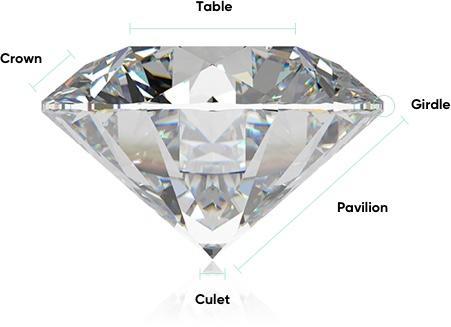
Asscher Cut Diamond Engagement Rings from Ritani
Asscher-Cut Three-Stone Tapered Baguette Diamond Engagement Ring
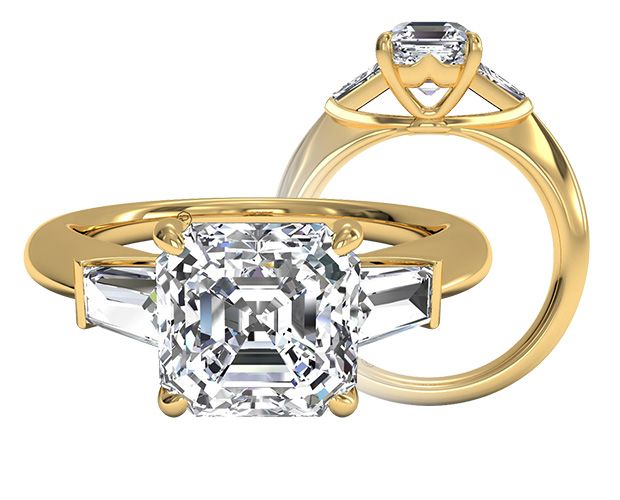
Breathtaking design with a gorgeous Asscher cut diamond center stone flanked by two tapered baguette diamonds set in an 18kt yellow gold band. A timeless three-stone engagement ring for a classic bride.
Asscher-Cut Tapered Three-Row Pavé Diamond Engagement Ring
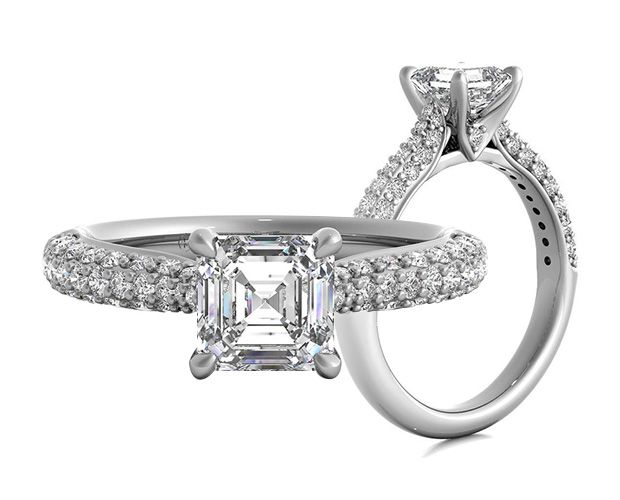
With this engagement ring and its rows of pavé-set round brilliants, you get triple the sparkle. Two hidden diamonds are set at each side of the Asscher cut center stone. This beautiful shimmery ring in 18kt white gold shines in all directions.
Asscher-Cut Tapered Channel-set Diamond Band Engagement Ring
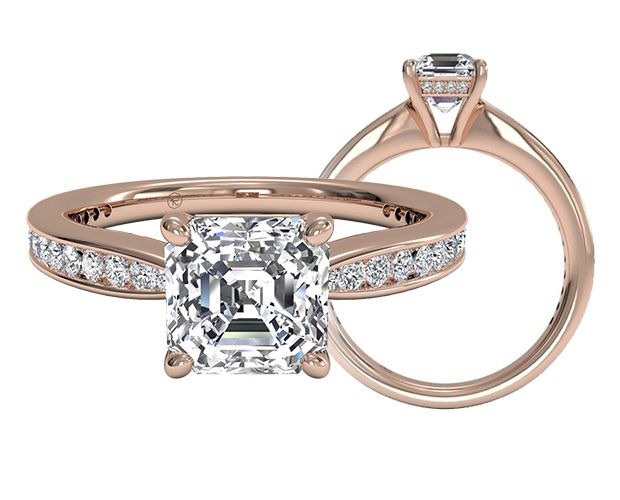
A magnificent Asscher cut diamond sits on top of a bright hidden halo while a tapered 18kt rose gold band with channel-set round brilliants draws all the focus back to the step cut diamond. A fantastic design for the most romantic brides.
Three-Stone Asscher and Trillion Diamond Engagement Ring

An extraordinary Asscher cut diamond is surrounded by trillion cuts on each side, creating a radiant effect.
Asscher Cut Diamond Classic Solitaire Engagement Ring
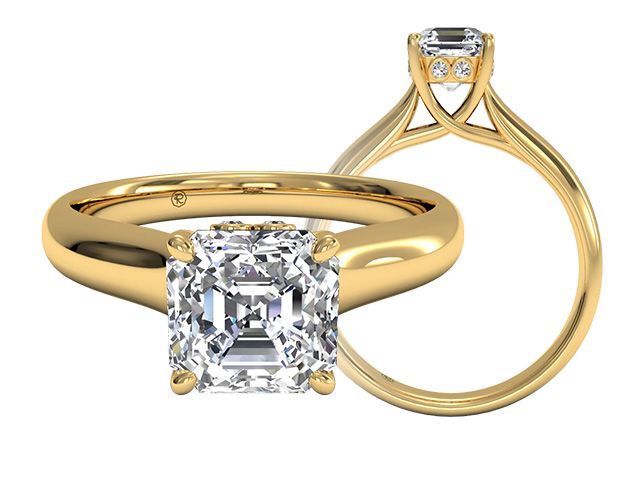
For traditional brides, an elegant 18kt yellow gold solitaire with a hidden surprise. The elevated setting makes the Asscher cut diamond pop and float over your finger, and when you look under it, you will find bezel-set round brilliant diamonds shining from each side.
Final Note on Asscher Cut Diamonds
They might not be as shimmery as round brilliant cut diamonds, but Asscher’s have their own charm. If you are looking for a vintage, glamorous feel, an Asscher cut diamond engagement ring might just be the ideal shape.
Explore our stunning natural and lab-grown diamond inventory at Ritani.com and find the ideal engagement ring for you.


